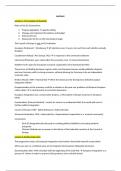Summary
Summary European Integration and Democracy Lecture Notes
- Course
- Institution
- Book
This guide travels through all the lecture material, week by week, in a clear and structured way. This lecture guide is an amendment to the one already posted - as the 1st Year BA Programme changed in 2023-24. Allowing you to understand all the basic knowledge of the European Integration and De...
[Show more]




